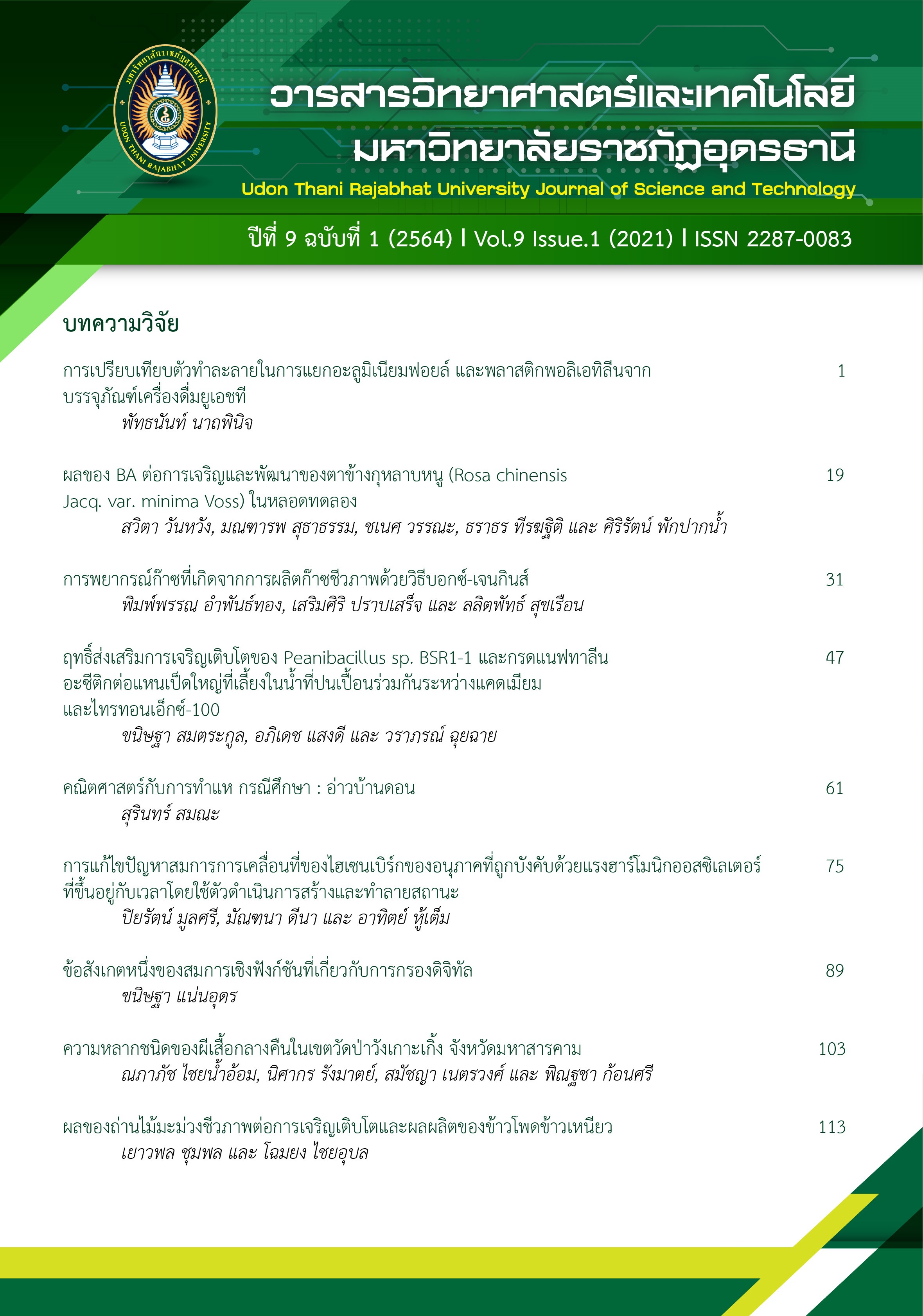COMPARISON OF SOLVENTS TO SEPARATE ALUMINUM FOIL AND POLYETHYLENE PLASTIC FROM UHT BEVERAGE PACKAGING
Main Article Content
Abstract
This research aimed to compare the suitable solvent to separate aluminium foil and polyethylene plastic from UHT beverage packaging. The parameters studied were as follows: 1) solvent types; blended organic solvents among benzene, ethanol, and water; mixtures of organic and inorganic acid prepared from acetic acid and nitric acid in the presence of water; and a single organic acid as acetic acid; 2) solvent concentrations; and 3) separating time affecting recovery and loss percentages resulted by those parameters were evaluated. The results reveal that all blended organic solvents could be used to separate aluminium foil from polyethylene plastic based on the principle of dissolution of polar and non-polar solvents. The non-polar solvents created an interaction between the solvent molecule and the polyethylene plastic, while the polar solvent with the acidity formed the ionic interaction with aluminium oxide which caused the polyethylene plastic be separated from aluminium foil. The blended organic solvents consisted of benzene, ethanol and water with the ratio of 35:35:30 at 60o C for 60 minutes could separate polyethylene plastic from aluminium foil. The highest recovery percentage and the loss percentage of 57.78% and 2.68%, respectively, could be obtained. However, the separation process was not complete at this ratio. The mixtures of organic and inorganic acid prepared from 5 vol% of acetic acid, 4 vol% of nitric acid, and water at 60o C for 30 minutes could separate polyethylene plastic and aluminium foil. Likewise, the highest recovery percentage and the loss percentage of 74.20% and 3.55%, respectively, could be obtained. The separation process was not complete at this ratio also. For this research, it could be concluded that the organic acid combined with inorganic acid using 10 vol% of acetic acid and 2 vol% of nitric acid at 60o C for 60 minutes performed the highest recovery percentage of 98.50% and the lowest loss percentage of 1.50%. Moreover, the single organic acids, e.g., 10 vol% of acetic acid at 60o C for 120 minutes performed the highest recovery percentage of 98.04% and the lowest loss percentage of 1.96% without unseparated sample left. Thus, both solvent types were suitable to separate polyethylene plastics and aluminum foils from UHT beverage packaging.
Article Details
References
สำนักวิจัยเศรษฐกิจการเกษตร. (2562) สถานการณ์โคนมโลกและไทย ปี 2562. สืบค้นเมื่อวันที่ 5 เมษายน 2563, จาก http://dairydevelopmentprogram.weebly.com /blog-36153634361936603617362636403586/-2562
Abreu, M. (2002). Recycling of tetra pak aseptic cartons. Retrieved April 5, 2020 from http://www.researchgate.net/publication/268399248_Recycling_ of_Tetra_Pak_Aseptic_cartons
Burton, H. (1994). Ultra-high-temperature processing of milk and milk products. Champman & Hall.
Cui, Z. W. (2006). Recovery of aseptic paper packaging. China Pulp. Paper Ind., 27, 80–81.
Gordon, L. (1996). The environmental profile of tetra pack aseptic cartons. China Packag, 16, 29–31.
Han, Z. F. (2007). Separation reagent of aluminum–plastic composite films. Patent CN1903965.
Hansen, C. M. (1999). Hansen solubility parameters (chapter 11, pp. 204–206). A User’s Handbook. CRC Press.
Kinkaew, C., & Apichartpattanasiri, S. (2018). Recycling of aluminum and plastic from laminated aluminum packaging films by metallurgy method. In: Proceedings of The 3rd National Conference. RTUNC 2018, 25 May 2018. Ubonrachathani, Thailand. p. 297-304.
Olafsson, G., Jäagerstad, M., Öste, R., & Wesslén, B. (1993). Delamination of polyethylene and aluminium foil layers of laminated packaging materials by acetic acid. J. Food Science, 5(1), 215-219.
Prawisudha, P., Mu-min, G. F., Yoshikawa, K., & Pasel, A. D. (2014). Experimental study on separation of metal layer in aluminum plastic packaging by employing hydrothermal process. Retrieved April 5, 2020, from https://pdfs. semanticscholar.org/73dc/e3b6c9c000728e6920f6437f42a067eabd39.pdf
Su ,Y. H., Hu, H. Y., & Duan, A. H. (2010). Separation and purification of benzene–ethanol–water waste liquid. J. Yunnan Normal University, 40, 59–62.
Wang, C., Wang, H., & Liu, Y. (2015). Separation of aluminum and plastic by metallurgy method for recycling waste pharmaceutical blisters. J. Cleaner Production, 102, 378-383.
Wang, C. C., & Wang, P. (2005). Recovery and reuse technology of polyethylene–aluminum composite packing materials. J. Beijing Instit. Civil Eng. Arch, 21, 63–64.
Wang, L. (2006). Discussion on production and recovery of Tetra Pak. Packag. Eng, 27, 79–81.
Wang, Z., Gao, B., Yang, Y., Tao, W., Liu, F., Shi, Z., & Hu, X. (2017). Studies on waste heat recovery in aluminum electrolysis. Retrieved April 5, 2020, from https://www.researchgate.net/publication/320280843_Studies_on_ Waste_Heat_Recovery_in_Aluminum_Electrolysis.
Xiao, J., Li, F., Zhong, Q., Bao, H., Wang, B., Huang, J., & Zhang, Y. (2015). Separation of aluminum and silica from coal gangue by elevated temperature acid leaching for the preparation of alumina and SiC. Hydrometallurgy, 155, 118-124.
Yan, D., Peng, Z., Liu, Y., Li, L., Huang, Q., Xie, M., & Wang, Q. (2015). Optimizing and developing a continuous separation system for the wet process separation of aluminum and polyethylene in aseptic composite packaging waste. Waste Management, 35, 21–28.
Yang, T., Zhou, C. S., & Zhu, X. (2005). The critical behavior of benzene–water-ethanol ternary solutions. Acta Physica et Chimica Sinica, 21, 439–442.
Zhang, S. F., Mei, X. X., & Zhang, L. L. (2012). Research progress of separations technology of aluminum-plastic in aseptic composite packaging. China Pulp & Paper, 31, 65–68.
Zhang, S. F., Zhang, L. L, Luo, K., Sun, Z. X., & Mei, X. X. (2014). Separation properties of aluminium– plastic laminates in post-consumer Tetra Pak with mixed organic solvent. Waste Management & Research, 1–6.
Zhang, S. F., Zhang, L. L., & Mei, X.X. (2011). Research on aluminum–plastic separationprocess with benzyl alcohol-water method. China Pulp. Paper Ind., 32, 43–46


